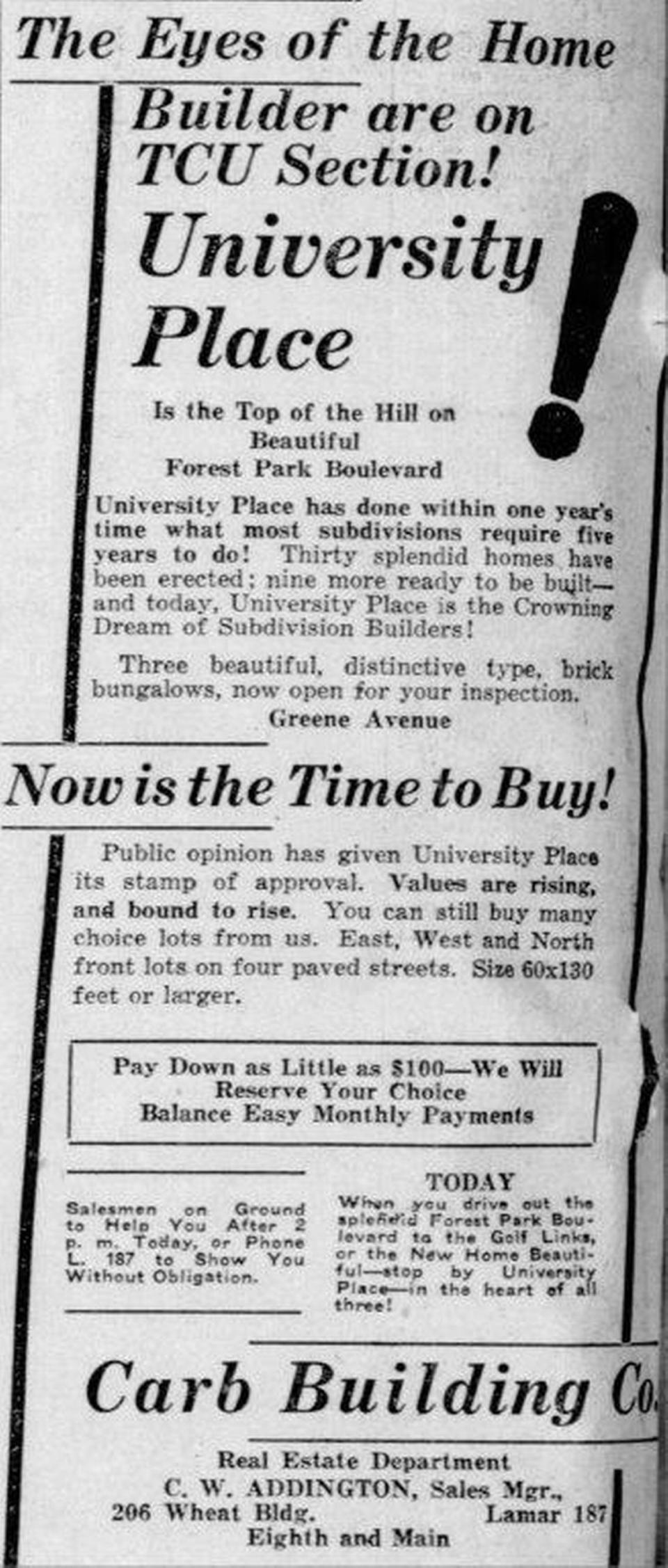Us Uniquely Fort Worth stories celebrate what we love most about Cowtown, its history and culture. Story suggestion? Editors@star-telegram.com.
When Texas Christian University moved from Waco to southwest Fort Worth in 1911, a new suburb sprang up nearby to serve the university community.
The addition was four miles from the city, a long journey with no paved roads and no streetcar service. Fort Worth police didn’t even patrol there because it was outside the city limits. Residents relied on the Tarrant County Sheriff for law enforcement. But the future looked bright.
The area around TCU was ripe for development. The rolling hills were high enough to get a cooling westerly wind, with good soil and a good water supply by tapping into the water table not far below. There was also talk that the Northern Texas Traction Co. would build a tram line to the campus in the near future. What the area did not have were municipal utilities, which also stopped at the city limits.
The new subdivision between Forest Park Boulevard and the TCU campus was called University Place. In the beginning, there were only a handful of bungalow-style houses separated by empty lots. Over the next twelve years, however, TCU grew, and so did the surrounding neighborhood. Real estate agents called it “one of Fort Worth’s nicest suburbs.” All homes were custom built in the beginning and not built by developers. When one occasionally came up for sale, it was usually very nice with features such as a concrete foundation, porte-cochere and even servants’ quarters.
But the houses were not cheap. In 1920, a real estate agent advertised a house for $6,800, “cash payment subject to conditions,” which was out of reach for most young homebuyers.
As a residential area, University Place really took off when Carb Land and Building Co. arrived in 1923. Carb had deep pockets. It was able to purchase a parcel of land and put money into construction and market it as a desirable subdivision. The offices were located downtown on the second floor of the venerable Wheat Building, an office space that had seen better days but was not a retail building.

Carb divided his property into plots of 20 by 30 meters, five to one hectare. The lots could be purchased for $1,500 with a $100 down payment and two to three years to pay off the balance.
Each plot had a facade of 18 meters high on the street side. Accessibility was another point that made the allotment particularly attractive. By 1923, Forest Park (“Fort Worth’s most popular pleasure boulevard”) was paved with asphalt all the way from the city, and the promised streetcar line that followed the same route connected residents to the city. There was no lot more than two blocks from the line. The neighborhood’s streets were paved and some already had sidewalks and street lights installed.
By then, the neighborhood was within city limits, so every home would be connected to public utilities: telephone lines, gas, electricity, water, and sewerage. University Place homeowners would no longer have to rely on outbuildings, well water and kerosene lamps. Being within the city limits, they were also assured of police and fire protection.
Just as important to potential buyers, University Place had “sensible restrictions to ensure the class of neighbors you would want living in your neighborhood.” In reality, this meant that Carb would not sell to black or Latino people or “mercantile interests.”
The final sign was the presence of the city’s first municipal golf course, which opened in 1923 just a few blocks from TCU. For the homeowner expected by Carb, a golf course within walking distance was the last word in luxury. Because it was the only public course, golfers otherwise had to join one of the country clubs to play.
Fort Worth was booming with new additions at the time – Riverside, River Oaks, Arlington Heights, Mistletoe, Ryan and Forest Park – but none could boast the amenities of University Place: a university and a golf course right next door, in addition to reasonably good amenities. priced lottery tickets. They were all part of the ‘Own Your Own Home’ movement that swept the country after World War I.
The Carb Co. was a full-service real estate company that also sold lots and built houses. In 1924, Carb Building Co. launched. a “gigantic housing development program” with 30 “beautiful bungalows” under construction, all in brick, tiles or stucco; no wood frame houses in University Place. Three floor plans were available, with five or six rooms each. All house plans had deep porches because this was before air conditioning, and front porches were for socializing and staying cool during North Texas summers. They also had garages, a recent amenity in home construction that reflected the advent of the age of the automobile.
The completion of the first twelve homes on Greene Avenue prompted a ‘grand opening’ of the subdivision. On Sunday, May 18, the company invited Fort Worth to come out to “inspect” the homes between 2 and 9 p.m. In the following weeks, almost 6,000 people came to Carb’s showroom. By the end of the year, Carb had built and sold 45 homes, and it was just getting started.


Carb opened the second section of University Place in May 1925. It offered eight architectural “styles” and three floor plans. The company had also joined forces with Ellison Furniture and Carpet Co. to complete the interiors for buyers at a nice profit for both companies.
The suburb was a hotbed of intellectualism thanks to all the teachers and administrators who lived there – and their wives. The latter did not consider themselves only housewives. The ladies wanted to socialize and at the same time “contribute to the cultural and social development of their community.” In 1925, they formed the University Place Study Group, which held their first meeting in TCU’s Brite Chapel. They divided themselves into three ‘sections’ depending on each lady’s main interests: art, music or books. Each department had its own membership lists and meeting dates and places.
In the early years, all meetings were held at private homes, which severely limited the number of members they could register. Within two years, the total membership reached 100 women and one “honorary” man, Prof. Samuel P. Ziegler of the TCU art department.
Over the next half century, University Place’s book, art and music clubs would keep the culture and arts alive in southwest Fort Worth. They gained some status by joining the Federation of Fort Worth Women’s Clubs. Their regular monthly meetings eventually took a back seat to developing social events, starting with holding four ‘general meetings’ a year.
It helped grow their membership that their meetings and soirees were published in the Star-Telegram. Ultimately, they had to find larger locations for their general meetings, such as University Methodist Church and River Crest Country Club. They filled the calendar with “autumn tea,” “guest day tea,” and “Christmas parties,” which were much more fun than book reviews and music recitals. The three divisions eventually merged their interests, and the distinction between ‘departments’ lost all meaning.
Today, the “Book Section” is the only group still active, although it only has about 15 active members. In 1952, they planted a memorial tree in the middle of the Bluebonnet traffic circle, just steps from where they started. Fifty years later they gathered at the same spot to replant their memorial tree. They’ve dropped the “Study Club” name entirely in favor of “Book Club,” but they have no plans to hang it up. University Place is still their home, and books still bring them together after almost 100 years.
Author-historian Richard Selcer is originally from Fort Worth and is a proud graduate of Paschal High and TCU.






